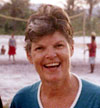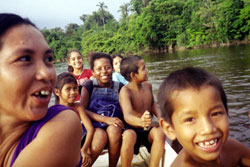
Memories of Micobie
Finding welcome in an Amerindian village in the heart of Guyana's rainforest
By Maxine Bell
October 2004
Return to Table of Contents
Print Article
Micobie is a picturesque Amerindian village in the heart of Guyana's rainforest. The village sits on a steep, rocky hill above the Lower Potaro River. On the opposite shore, white sand dunes glisten in the sunlight. The scene is like my idea of paradise with tall stately palm trees towering above all other trees.
The first thing you see on reaching the top of the hill is a banab and a 500-square-foot clearing of white sand. Bordering the clearing are the school and the headmistress' house, the medical centre and the craft centre. The villagers live along the riverbank, around the hilltop and inside the forest edge.
I was invited to Micobie this past August by Ms. Jackson, school headmistress, to teach sewing techniques and crafts to the village women. On arrival I was warmly greeted by friendly and soft-spoken women and children. In the next three weeks I got to know them by name and fell in love with all, especially the children.
Ms. Jackson welcomed me into her home, and shared her great cooking and hospitality with me and others in the village. Often she would say, "God gives me so much, I must share with others." I hope to remain in contact with her and learn more from her goodness.
The classes were a success, especially the stuffed-toy making. Two of my more ambitious students were 11-year-old girls. Classes started at 8:30 in the morning, with an hour for lunch, and then continued until 4:30 in the afternoon.

Women and children row across the river from their village to swim off the sandy shores on the opposite bank. Micobie, Guyana.
After, we would go swimming in the brown "coca cola" water of the Potaro River. My swimming companions were children of all ages, great swimmers, and some of the mothers. A few times we crossed the river in a rowboat to swim off the white sand dunes on the opposite shore.
One Sunday I was playing school with little Tellicia. I was amazed at how quickly she grasped some mathematical concepts. She wasn't as quick with writing a short story, but on examining what she wrote I was touched that she closed her story with, "I love you Maxine."
While in Micobie, I had the opportunity to go to a seminar on HIV/AIDS at the hospital in the nearby village of Mahdia. Dr. Ramsammy, the Minister of Health, was guest speaker. On the way, the minibus had difficulty getting up some of the hills, so we often had to get out and climb them on foot. I arrived a little late as a result, but still found the seminar informative. I was pleased to learn of the efforts and finances extended by the Ministry of Health in combating HIV/AIDS, a rising problem here in Guyana.
On another day, Guyana's Director of Community Development, Philomena Shahy Shury, and Regional Director Peter Ramotar came to Micobie to talk to the villagers about community development projects. Meeting outdoors under the banab, the villagers elected a committee to undertake the development of a fowl farm. They will begin work on the project next month.
During my visit, I also had the opportunity to watch villagers stripping and "retrashing" the benab roof. "Trash" is the name of a type of palm leaf used. As they worked, they explained the process to me.
Returning to Georgetown, I had my finger pricked and blood tested for malaria, which is rampant among the villagers. The mosquito responsible is found deep in the forest where the people have their farms. Test results showed that I didn't pick up any of that misery. Instead, what I received from Micobie were many joy-filled memories of the people, who showed a stranger much love, openness and trust.
Maxine Bell is leaving Georgetown to work with Amerindian peoples in Ashialton in the interior of Guyana. She and Barbara White will go there as a Scarboro team hoping to set up a program to care for seniors in their homes, and to help out at the hospital, clinic, schools and in the community.
Return to Table of Contents
Print Article